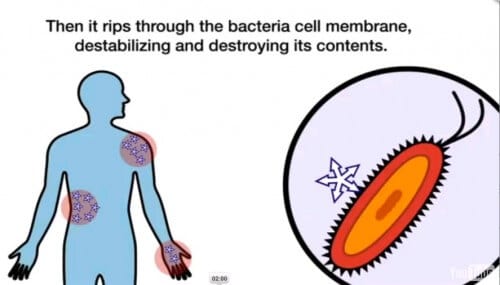IBM's research program in the field of polymers for nanomedicine has been ongoing for four years, based on a decades-long tradition of developing materials in the field of microelectronics.

Scientists at IBM and the American Institute for Bioengineering and Nanotechnology have developed a water-based antibacterial gel capable of penetrating bacterial surfaces and infected tissues and completely eliminating drug-resistant bacteria, through mere contact with these bacteria. The results of the study are published this month in the scientific journal Angewandte Chemie
The synthetic gel, created in a spontaneous process by heating a liquid-solvent to the temperature of the human body, is the first treatment of its kind that is biodegradable in a biological process and compatible with the body's structure and biological processes, using a non-toxic substance. All these, make it an ideal tool for fighting serious health risks that threaten hospital workers, visitors and patients.
Household surfaces are disinfected using substances such as alcohol and bleach. However, moving from these surfaces to the treatment of drug-resistant bacteria that cause skin infections or infectious diseases is a more complex challenge: conventional antibiotics are becoming less and less effective due to the development of resistant bacteria, while the materials used for household cleaning are not suitable for use on the body's surface.
The scientists at IBM have developed an antibacterial gel that can be applied and is easy to use - and consists of 90% water, combined with polymeric materials with a unique structure. If this development reaches the stage of commercial medical use, it will be particularly suitable for ointments and injection treatments for healing wounds, coating implants and drains (catheter), skin infections and even more invasive infections. Bacterial contamination surfaces are capable of multiplying on any tissue or surface. Such groups of infected cells are found in 80% of infection cases, and are typical of a wide variety of areas of the body, especially in the use of medical equipment. These infections make up a significant part of the infections in hospitals, which are one of the five most common causes of death in the US, and are responsible for the expenditure of 11 billion dollars from the American health budgets.
Despite advances in sterilization and disinfection technologies, infections associated with the use of medical equipment continue to exist and affect patients. This is also due to the development of drug-resistant bacteria. According to data from the American Center for Disease Control, the cost of treating patients with drug-resistant bacteria is estimated at $20 billion a year, and eight million additional hospital days.
Through precise tailoring of polymers, the researchers at IBM were able to design giant molecules, which include a large amount of atoms, which combine solubility in water, a positive electrical charge and characteristics of biodegradability. When these molecules are mixed with water and the solution is heated to the temperature of the human body, the polymers undergo a self-assembly process, turning into a synthetic gel that is easy to apply and use. This rare ability results from internal interactions between the polymers through what is known as a "molecular zipper": like the teeth on a garment zipper that interlock with each other - the polymers know how to form a bond that turns the water-based solution into a thick gel. Since this gel maintains the properties of the soluble polymers, they can remain in place under different physiological conditions, and continue their antibacterial activity.
The approach of the researchers at IBM is fundamentally different from the existing methods for fighting drug-resistant bacteria.
The new technology appears in an era where antibiotics and previous drugs have difficulty dealing with resistant bacteria - and offers a new method of fighting these bacteria: while the antibiotic focuses on the internal mechanism of the bacteria, the gel eliminates the bacteria by damaging the membrane, the outer membrane essential for its existence. When the new gel is applied to an infected surface, its positive electrical charge attracts all negatively charged bacterial membranes, sucking them in much the same way a black hole sucks in massive objects.
IBM's research program in the field of polymers for nanomedicine has been ongoing for four years, based on a decades-long tradition of developing materials in the field of microelectronics.

4 תגובות
What about a black hole? And what does membrane pumping do? Does it leave the bacterium without a membrane? Does it pull all the bacteria into the solution? It is not clear
I didn't understand how it is better than chlorine at a concentration of 1000 ppm that is used today.
In the page linked from the bottom of the article
Can I post a link to the video?